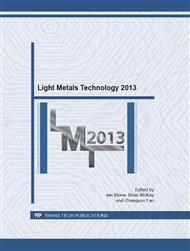p.693
p.698
p.703
p.711
p.716
p.721
p.726
p.731
p.736
Enhanced Mechanical Properties of AA5083 GTA Weldments with Current Pulsing and Addition of Scandium
Abstract:
AA5083 alloy is welded with gas tungsten arc welding using optimized welding parameters. Al-Si-Sc master alloy filler with varying contents of scandium is used for welding. Welding was carried out with and without AC-pulsed current techniques. A narrow heat affected zone with more refined grain structure is observed in the case of the pulsed current technique. Furthermore, it is observed that the columnar solidification structure in the fusion zone was suppressed and fine equiaxed grains were formed in the weld zone with increasing scandium content, which is attributed to the grain refinement effect of scandium with the generation of increased nucleating sites during weld solidification. This effect is reflected in mechanical properties also. An increased hardness of about 10 % results with pulsed current technique compared to about 20 % with an addition of 0.75 % scandium. However, in the case of tensile properties pulsing resulted in about 8 % increase in tensile strength and addition of 0.75 % scandium resulted in about 40 % increase in tensile strength. Both the pulsed current technique and the addition of scandium were observed to be better in increasing not only strength but also elongation due to the refined grain structure in the weld fusion zone.
Info:
Periodical:
Pages:
716-720
Citation:
Online since:
July 2013
Price:
Сopyright:
© 2013 Trans Tech Publications Ltd. All Rights Reserved
Share:
Citation:


